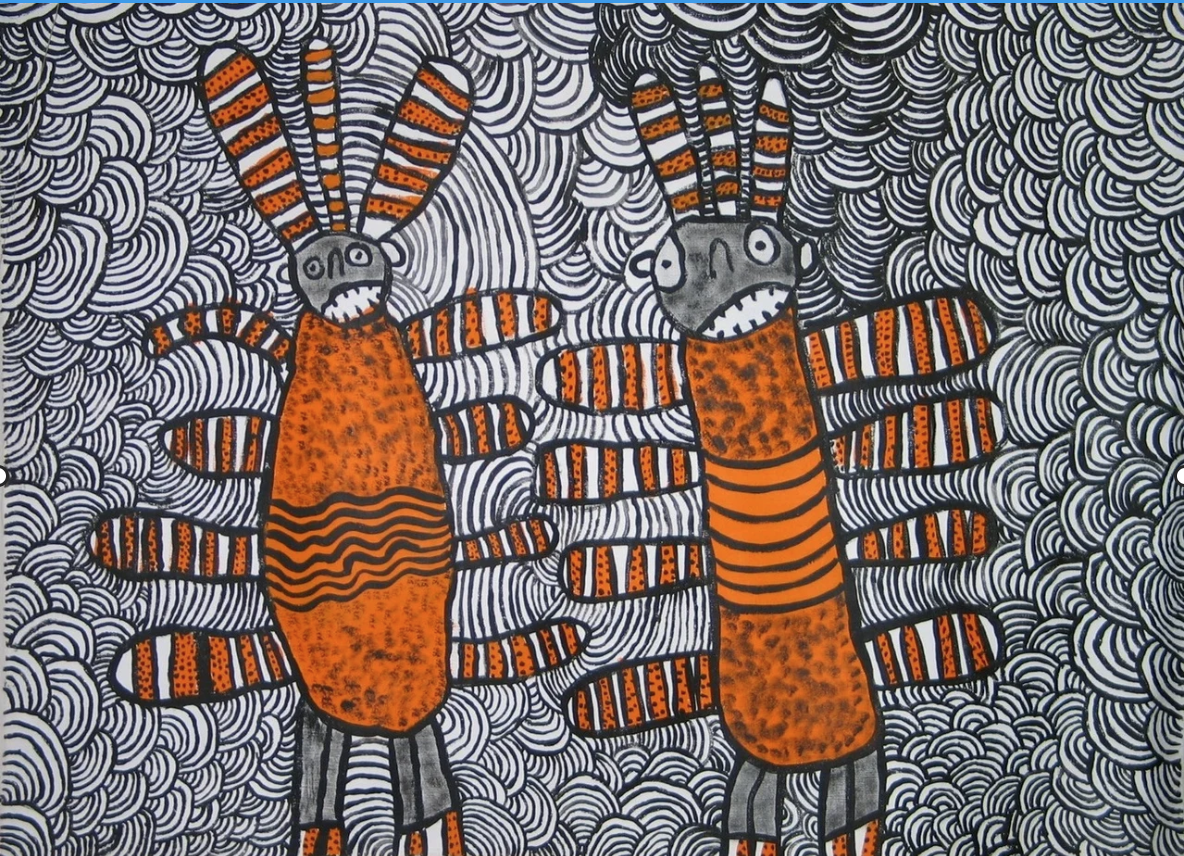Ancient Ghosts of Aboriginal Australia
"Mamu (Spooky Spirits)," a 2006 painting by Nura Rupert. © NURA RUPERT, COURTESY OF ERNABELLA ARTS/THE CONVERSATION
Aboriginal Australians have considered themselves to share the landscape with many spirits for tens of thousands of years (Clark 2007: 142). Some spirits are dangerous as they prey on humans, but many of these would not be considered ghosts even though they could appear human-like, which can also be known as witches or devils (Clark 2007: 148). The colonial invaders recorded the belief in these terrible spirits after arriving in the 18th century when Indigenous Tasmanians referred to the Europeans by a name that translates to "white devil (Blackhouse 1843: 181-2)" (Clark 2007: 143). [Certainly an accurate description.] The colonisers were thought to be spirits or the ghosts of relatives returned from the afterlife with their "rotting skin peeling off" (Clark 2007: 143). Many of the words that Aboriginal Australians use to refer to white people mean 'ghosts' in their native languages (Clark 2007: 143).
*I’d show photos taken of people with the white cover on their face, but I’d like to follow the traditions that matter to the members. They are easily found online.
[According to sources written in Australia's "historic" period] Aboriginal South Australians believed in a powerful element of the human spirit called the prupi (Dawson 181: 51). Gupas, are different because they are the general spirits of the dead, of any cultural background. They are typically observed at night around buildings or other human constructions as "shades of human form or spirit lights" and are believed to eventually move on to where the ancestors reside (Clark 2007: 153).
Modern Aboriginal Australians continue to keep the oral tradition of spirits alive. As ghosts are the "spiritual remains of people who were once alive" they are created when the dead don't move on and join the Ancestors in Skyworld or the Land of the Dead (Clark 2007: 148). Reasons for this include the usual, and notably, the lack of performing mortuary duties or if their name is not avoided, because hearing it calls them back. Having a proper burial is another huge aspect in the creation of ghosts in Australian traditions because gupa tend to haunt the location of their deaths, which is why there is folklore about haunted houses, rivers, and highways, or where their body lays, like a cemetery. Land is tied to ghost gupa and prupi traditions because the ancient oral traditions, most often shared in song harken back to the initial arrival of the first Australians 50kya. In the songs, the goddess/creator spirit, the Morning Star/planet Venus, led the first humans, the Djanggawul sisters, across the ocean to Australia via songlines (aka the Dreaming track) which continue to be used to travel over sea and land to this day (Norris 2009; Japingka Aboriginal Art Gallery 2017; Malcolm 2016; Cairs 2003). This same goddess, named Barnumbirr/Banumbirr is also tied to death rituals too. Because the land is intrinsically tied to death via grave mounds and their tutini (markers placed around the mounds), the creator goddess is venerated within the death rituals, returning people to their ancestors in the Dreamtime (Crisp 2017).
In a real "everything changed when..." moment, new Dreaming stories are said to have been created after the European colonisers invaded to explain why things were so different (Coolabah 2016: 40-41). In Master of the Ghost Dreaming, Jangamuttuk described the 'Ghost Dreaming' ceremony to "render the ghost colonisers powerless and dispel the destructive influence of European imperialism on Aboriginal culture" (19). Europe was also described in the new stories as a forbidden land of suffering, death, and destruction with no songs (Jangamuttuk: 32; Coolabah 2016: 41). In another turn, if Aboriginal people were abducted from their ancestral homes they could not move on to the Dreaming because they had lost their connection to the land (The Undying: 90-91). They'd be trapped on Earth, repeating the same things they did in life, but with no effect and no purpose (Coolabah 2016: 44-48).
Ghosts are taken seriously in Australia when once are seen the community will discuss what to do if the sighting is relevant. This can often as a lure, leading to conflict within the community since it's tied to a certain location and an unresolved tension-filled relationship with a particular family. Historic places are treated as haunted, which led to the prohibition of visiting cemeteries after dark along with the warning at the beginning of movies for Aboriginal actors in the eventuality of their death.
Extra reading:
Please read —> First Contact Part 2 - 'Jump up Whitemen' & Ghosts - European Explorers & Aboriginal Spiritual Beliefs
And listen to —> Indigenous Ghost Stories podcast
